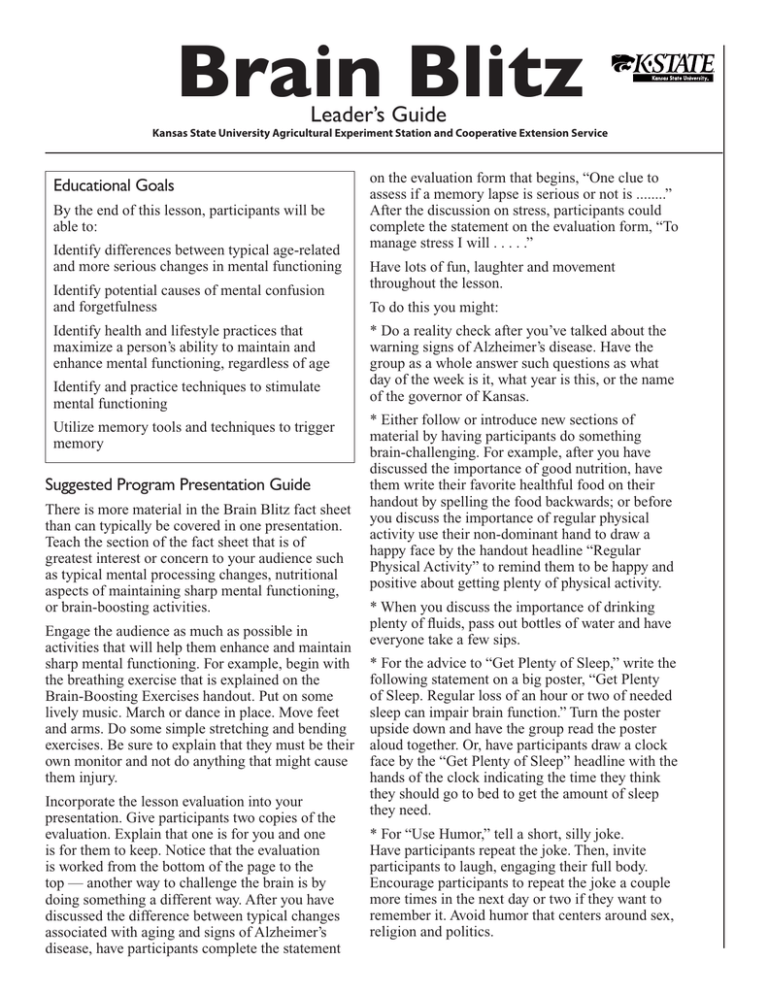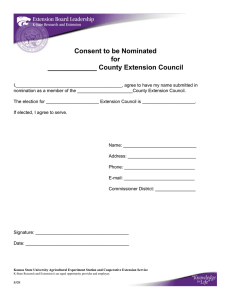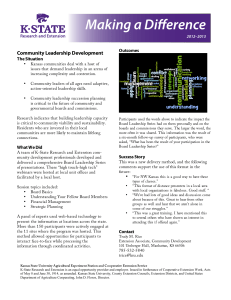
Brain Blitz
Leader’s Guide
Kansas State University Agricultural Experiment Station and Cooperative Extension Service
Educational Goals
By the end of this lesson, participants will be
able to:
Identify differences between typical age-related
and more serious changes in mental functioning
Identify potential causes of mental confusion
and forgetfulness
Identify health and lifestyle practices that
maximize a person’s ability to maintain and
enhance mental functioning, regardless of age
Identify and practice techniques to stimulate
mental functioning
Utilize memory tools and techniques to trigger
memory
Suggested Program Presentation Guide
There is more material in the Brain Blitz fact sheet
than can typically be covered in one presentation.
Teach the section of the fact sheet that is of
greatest interest or concern to your audience such
as typical mental processing changes, nutritional
aspects of maintaining sharp mental functioning,
or brain-boosting activities.
Engage the audience as much as possible in
activities that will help them enhance and maintain
sharp mental functioning. For example, begin with
the breathing exercise that is explained on the
Brain-Boosting Exercises handout. Put on some
lively music. March or dance in place. Move feet
and arms. Do some simple stretching and bending
exercises. Be sure to explain that they must be their
own monitor and not do anything that might cause
them injury.
Incorporate the lesson evaluation into your
presentation. Give participants two copies of the
evaluation. Explain that one is for you and one
is for them to keep. Notice that the evaluation
is worked from the bottom of the page to the
top — another way to challenge the brain is by
doing something a different way. After you have
discussed the difference between typical changes
associated with aging and signs of Alzheimer’s
disease, have participants complete the statement
on the evaluation form that begins, “One clue to
assess if a memory lapse is serious or not is ........”
After the discussion on stress, participants could
complete the statement on the evaluation form, “To
manage stress I will . . . . .”
Have lots of fun, laughter and movement
throughout the lesson.
To do this you might:
* Do a reality check after you’ve talked about the
warning signs of Alzheimer’s disease. Have the
group as a whole answer such questions as what
day of the week is it, what year is this, or the name
of the governor of Kansas.
* Either follow or introduce new sections of
material by having participants do something
brain-challenging. For example, after you have
discussed the importance of good nutrition, have
them write their favorite healthful food on their
handout by spelling the food backwards; or before
you discuss the importance of regular physical
activity use their non-dominant hand to draw a
happy face by the handout headline “Regular
Physical Activity” to remind them to be happy and
positive about getting plenty of physical activity.
* When you discuss the importance of drinking
plenty of fluids, pass out bottles of water and have
everyone take a few sips.
* For the advice to “Get Plenty of Sleep,” write the
following statement on a big poster, “Get Plenty
of Sleep. Regular loss of an hour or two of needed
sleep can impair brain function.” Turn the poster
upside down and have the group read the poster
aloud together. Or, have participants draw a clock
face by the “Get Plenty of Sleep” headline with the
hands of the clock indicating the time they think
they should go to bed to get the amount of sleep
they need.
* For “Use Humor,” tell a short, silly joke.
Have participants repeat the joke. Then, invite
participants to laugh, engaging their full body.
Encourage participants to repeat the joke a couple
more times in the next day or two if they want to
remember it. Avoid humor that centers around sex,
religion and politics.
* Help your audience “Maintain a Positive
Attitude” by shaking hands with at least two
people around them and thanking them for
something such as being a pleasant person to sit
beside or greeting you with a smile. This is a good
opportunity to teach the “arthritis handshake.”
Instead of grasping another’s hand, grasp them on
the forearm. The “arthritis handshake” is kinder
to those with arthritis and is less likely to pass
disease-causing organisms from hand to hand.
A handshake and greeting is good social contact —
another important way to keep the brain engaged.
Suggested Roll Calls or
Ideas to Introduce Brain Blitz
* Conclude the presentation by giving everyone
a copy of a positive, uplifting poem or a reading
that has at least 13 lines. Divide the group into
four smaller groups. Have each group take turns
reading lines aloud. Have everyone read the last
line together. Remind participants that reading
aloud engages different parts of the brain than
reading silently. Also, taking turns is more complex
than reading straight through. When reading as a
group, and especially when taking turns, it is likely
they may miss the meaning of the words as they
concentrate on remembering their turn. To grasp
the meaning of the words, they may have to read
the same text over later.
* Give each participant an unlined index card and
have them write the following sentence in pictures:
“I love Kansas bread.”
* Ask participants to complete one copy of the
lesson evaluation and return it to you. Have them
complete the second evaluation as their “takehome messages” reminder.
* Something I do to keep my mental processes at
their best.
* My favorite brain-teaser activity or game is …
* A brain workout that can be done with a child
that is good for both of us.
* Name pairs of things that are opposite such as
brother/sister; up/down; salt/pepper; right/left.
* Spell your name backwards.
* Have each participant write his or her name or
draw something simple, such as a flower or a stick
person, on an index card using the non-dominant
hand. Then during roll call, the particpants show
their cards.
Donna R. Martinson
Family and Consumer Sciences Agent
K-State Research and Extension – Geary County
119 E 9th Street
Junction City, KS 66441
Phone: 785-238-4161
e-mail: dmartins@oznet.ksu.edu
K-State Research and Extension is an equal
opportunity provider and employer.
Brain Blitz Activities
Use your other hand
Connect the dots
Surprise your brain by using your nondominant hand to eat, comb your hair, button your
clothes, or other tasks.
solution
Alphabetical sentences
Arrange the words in each of the following
sentences alphabetically:
• Taking three or more different medications
(including over-the-counter drugs) can put you at
risk for poor nutritional health.
• One key to living well with life’s stresses is to
make sure there are enough times of relaxation to
balance out times of stress.
• The natural sweetness of fruit can satisfy
cravings for other sweets that may be higher in
calories and fat.
2
●
end
●
●
●
●
●
●
●
●
start
Breathe, Breathe, Breathe
Breathing deeply is one of the most important things
we can do to keep our minds mentally alert. Twenty
percent of the air we breathe goes to our brains. Seniors
are notoriously shallow breathers. Practice this breathing exercise, as advocated by Dr. Andrew Weil, on a
daily basis and especially before doing a mental aerobic
exercise.
You may want to do this sitting with your back straight,
lying on your back, or standing or walking.
Exhale completely through the mouth, making an
audible sound. Then, close the mouth and inhale quietly
through the nose to a count of four. Hold the breath
for a count of seven. Next, exhale audibly through the
mouth to a count of eight. Repeat for a total of four
cycles, then breathe normally.
The speed with which you do the exercise is unimportant. What is important is the ratio of four to breathe in,
seven to hold, and eight to exhale.
(Source: Aerobics of the Mind: 100 Exercises for a Healthy Brain,
by Marge Engelman)
Connect the Dots
Without lifting your pencil from the paper, draw four straight, connected lines which will go through all nine dots.
Think beyond the usual restrictions you put on yourself. (Your instructor has the solution to this puzzle.)
●
●
●
●
●
●
●
●
●
Read the recipe for better sleep upside down.
Mix well and sleep until done (rising time). Do not add alcohol within two to six hours of bedtime. Do not add a
stimulating book or television show just before mixing.
1 teaspoon honey in 1 cup hot water
1/2 hour soft music, reading or meditation while trying
to fall asleep
5 minutes muscle-relaxing exercise
1/2 hour quiet time before bed
1 humidifier
1 quiet, dark, comfortable room
1 regular bedtime hour
1 low fat snack
1 cup warm milk
Optional additions
Sleep patterns normally change as we age. Older adults take longer to fall asleep, waken more frequently and
spend less time in deep sleep. This is normal.
3
Recipe for Better Sleep
Brain Blitz
My Personal Goals and What I Learned
(Start at the bottom of the page and work up — it’s a good change for the brain!)
8. One more thing I have to say is ________________________________________________________
____________________________________________________________________________________
___________________________________________________________________________________.
7. Something I learned in Brain Blitz that I want to remember is ________________________________
____________________________________________________________________________________
___________________________________________________________________________________.
6) Draw a happy face in the box by the statement you think is most true for you:
There are many things I can
do to keep my mind sharp.
I expect that my mental
abilities will diminish as I get
older in spite of what I do.
5. One habit I plan to adopt because it will help me maintain my mental abilities is _________________
____________________________________________________________________________________
___________________________________________________________________________________.
4. To manage stress I will ______________________________________________________________.
3. My goal is to eat ________ cups of fruits and vegetables each day.
2. My goal for physical activity is ___________ minutes per day.
1. One clue to assess if a memory lapse is serious or not is _____________________________________
___________________________________________________________________________________.
Please return one copy of this to your instructor.
Brand names appearing in this publication are for product identification purposes only. No endorsement is intended,
nor is criticism implied of similar products not mentioned.
Publications from Kansas State University are available on the World Wide Web at: www.oznet.ksu.edu
Contents of this publication may be freely reproduced for educational purposes. All other rights reserved.
In each case, credit Donna Martinson, Brain Blitz, Kansas State University, November 2005.
Kansas State University Agricultural Experiment Station and Cooperative Extension Service
MF 2692
November 2005
K-State Research and Extension is an equal opportunity provider and employer. Issued in furtherance of Cooperative Extension Work, Acts of May 8 and June
30, 1914, as amended. Kansas State University, County Extension Councils, Extension Districts, and United States Department of Agriculture Cooperating,
Fred A. Cholick, Director.



